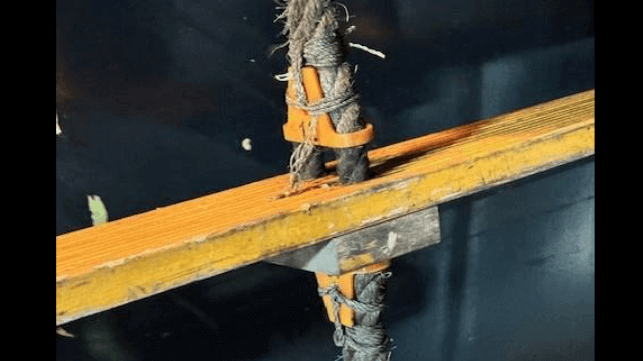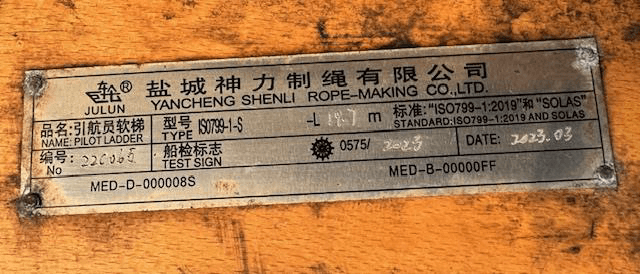One Bad Ladder Shows Common Shortcomings for Marine Pilot Safety
At least eight people died in boarding accidents last year, and bad ladders are part of the problem

Arie Palmers is a Dutch marine pilot and is closely involved in efforts to tighten pilot ladder safety. In this case, Palmers shows how one bad ladder can illustrate the dangerous gap between international requirements and real-world industry practice.
Recently I was involved in a case with a non-compliant and dangerous pilot transfer arrangement on a bulk carrier heading to Vlissingen anchorage for partial discharging.
At the 17th of August around 2324 local time the first pilot boarded the vessel at Wandelaar pilot station via the SWATH pilot vessel. The ladder that had been rigged was not used because the servicing pilot had been put on board via the retractable gangway of this boat, and therefore was able to step directly onto the deck of the vessel.
The agent asked me for an English explanation on why this ladder would not be safe. I considered it interesting enough for educational purposes to extend my reply a bit and share it online.
At 0219 local time the next morning (18th of August) the vessel arrived at Flushing roads to change the pilot. During this procedure it was established that the ladder did not meet international standards, regulations and requirements and was therefore not safe to use in accordance with SOLAS ch. V reg. 23 rule 2.1. And 3.1. The non-compliances that were noticed at that time were:
- All wooden steps were loose. (pictures and videos were made). No inspection or maintenance had been carried out in accordance with ISO799-2:2019 ANNEX A. Question: is pilot ladder maintenance and inspection implemented in the SMS system as required?
- All wooden steps were varnished, which is not in accordance with IMO A.1045 rule 2.1.2.4, ISO799-1:2019 rule 4.1 and is also mentioned in the well-known pilot ladder poster issued by IMPA in cooperation with the IMO (slippery and therefore a tripping hazard).
- No identification tag under the bottom spreader as per regulations ISO799-1:2019 rule 8.1
- Ropes seizings not as per regulations mentioned in ISO799-1:2019 rule 4.7
- Spreaders are not of a one piece construction as per ISO799-1:2019 rule 5.14
The most hazardous issue with this specific ladder was the fact that all steps were loose, in combination with the fact that those steps were also varnished. Steps will tilt when weight is put on them, and the varnish will cause a slipping/tripping hazard. Last year eight people, of which I know, have been killed attempting to board a vessel.
During the attempted transfer, a picture of the pilot ladder certificate was asked at 0223 and received at 0239. According to the provided certificate it appeared that the ladder had been built in December of 2020. A ladder needs to undergo a strength test or to be replaced after 30 months as per ISO799 - 1:2019 rule 10.4. Later it became clear that the provided certificate did not match with the presented ladder. This could not be checked at that time because there was no identification tag under the bottom spreader as per regulation (that is the reason a tag must be placed under the bottom spreader). The certificates belonging to the pilot ladder in use were never presented.
The combination of these deficiencies combined with the provided certificate led to an initial rejection to use this ladder to board the vessel. At 0515 the Dutch pilot launch was called away from Steenbank pilot station to Flushing roads to provide the pilot with access to the vessel without having to use the pilot ladder. During this time the agent had been informed to deliver new ladders to the vessel that would match international law. Unfortunately the agent did not answer the phone at that time so a voicemail message was sent by the chief pilot in the Scheldt Coordination Centre.
Upon boarding at 0515 the pilot (me) informed the captain of the deficiencies that were observed and that a new ladder was required to provide safe access. Images and videos were shown to the captain, and a video was shared with the captain on an iPhone.
Meanwhile the crew was busy to try and solve the problem of the loose steps. Upon arrival of the agent, he was told new ladders were to be provided. He told me the ladder was only one year old, which I later could check by having a look at the tag that was only present under the top step of the ladder.

Despite the fact that the ladder was only one year old, it was in a deplorable condition. The deck crew had been busy with the ladder for several hours. I could not check if the required repair rope had been used (three-ply tarred Marline of a minimum breaking strength of 800N and with a minimum diameter of 4mm or other suitable material of equivalent strength and diameter as per ISO799-1:2019 rule 4.7).
After these repairs, several people boarded and left the vessel again via this ladder. I therefore deemed it safe enough to conduct a pilot change in sheltered waters with the vessel not making way through the water (my mistake). Once I was on the pilot ladder to disembark, which I was not able to test with my weight on it before that time, I noticed the steps were still loose.
Port state control has been informed about the situation and has asked the agent to provide new ladders. Just to check, I asked a reputable manufacturer for an appraisal on a ladder with a length of 14 meters and 43 steps, and the costs of that would be: 965 euros. It is possible to order a ladder directly from various manufacturers in the region.
The class of the presented ladder has been asked why they certified this product, due to bad seizings, varnish etc., and they are investigating this case.
The vessel has no blame for having a ladder onboard that is not constructed as per international regulations: vessel orders a ladder, a ladder is delivered, and the crew should be able to rely on the fact that a proper piece of equipment had been purchased - but unfortunately a substandard quality ladder was delivered.
The vessel is however responsible for maintenance to be carried out on the ladder, especially when the ladder is constructed with whippings that will loosen over time. Purchasing a ladder where clamps are used, erases that problem. Equipment like pilot ladders need to be in the vessel’s SMS system so it is assured that proper maintenance and care will be executed. ISO799 provides you with the correct tools to do so. Also some manufacturers attach a maintenance record booklet to every ladder they supply, which is a good basis to implement it in the SMS system. It will definitely save lives when done the proper way.
I’ll end this article with some questions that are open for discussion:
- Why did the pilots in the port of departure consider this arrangement up to standards?
- Why did a class association, connected to IACS, approve a ladder that presumably was built under ISO799 standards? We can all see this ladder was way below any acceptable standard.
- Who is checking the quality of the certifying bodies?
- Why would an agent refuse to provide a new ladder (965 euros, remember)?
- Why does the flag state approve these practices?
- Who checks the SMS on every vessel?
The workgroup I am a part of is finishing the process of writing new and clear regulations on ladders, which will pass the IMO MSC this December. The same goes for the pilot ladder poster, which has been fully revised and redesigned.
Should you want to obtain more information regarding pilot ladders, I would like to point out the website www.pilotladdersafety.com. It has a lot of information on ladders and also good instructions that can be used in toolbox meetings.
Arie Palmers AFNI is a maritime pilot and CHIRP ambassador.
The opinions expressed herein are the author's and not necessarily those of The Maritime Executive.

